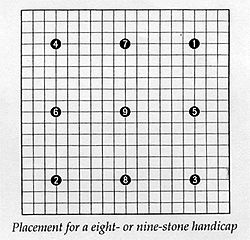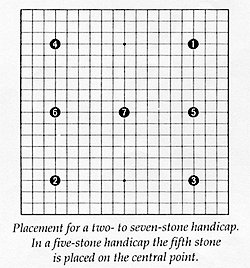Rankings and handicaps
Go has a ranking system that works as follows. Beginners are assigned the rank of 35-kyu and, as they learn more of the basic techniques, rapidly improve until they reach about 10-kyu. This rapid improvement assumes that the beginner studies and plays a few times a week for about three months. From 10-kyu up to 1-kyu, progress is usually much slower.Once an amateur graduates from the kyu ranks, he becomes an expert player and receives the rank of 1-dan ("shodan" in Japanese) from the go organization he belongs to. He can also determine his rank by measuring his playing strength against other players. Amateur dan rankings go as high as 7-dan. Professional rankings run from shodan to 9-dan, but they are on a different scale and do not correspond in strength to the amateur ranks. A professional shodan is much stronger than an amateur 7-dan.
Go also has a handicap system which gives weaker players a realistic chance of winning against stronger opponents. Players of equal strength use a method called "nigiri" to determine which player takes the white stones and which takes the black. When using nigiri, one player takes a handful of white stones while the other takes either one or two black stones. Both sets of stones are placed on the go board. If the number of black stones and white stones are both even or both odd, then the player who placed the black stones on the board plays with the black stones. If there is an even number of black stones and an odd number of white stones, or vice-versa, then the player who placed the white stones on the board plays with black.
When players of different ranks play, the stronger player always takes the white stones, and the handicap is determined by the difference in ranks between them. For example, if one player is 1-kyu and the other 2-kyu, then the 2-kyu player always takes the black stones and makes the first move. When a 1-kyu plays against a 3-kyu, the 3-kyu receives a two-stone handicap; when the 1-kyu player plays against a 5-kyu, the 5-kyu receives a four-stone handicap. This continues up to a nine-stone handicap, which is usually the largest handicap given. The same handicap system alsoapplies to amateur dan-ranked players.
Once the handicap has been established, the weaker player places the handicap stones on the star points in the order shown in the diagrams (top right). White then makes the first move, after which the players move alternatly.
The rule of ko
The three diagrams on the right show a special situation called "ko." Look at the position in Diagram 1. If it is Black's turn to play, he can capture a white stone by playing at 1 in Diagram 2, resulting in the position in Diagram 3. It might seem that White can recapture the black stone with "a" with his next move, but this would result in the same position as Diagram 1. If this were allowed and neither side were willing to give in, a capture-recapture situation could go on forever were it not for a special rule. The ko rule is quite simple.



